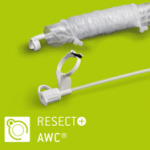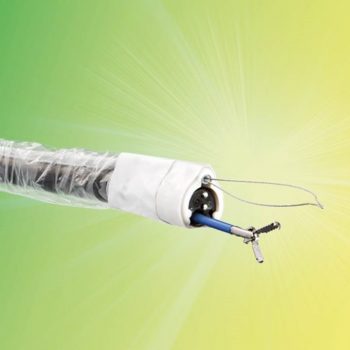AWC®: The novel tool reduces procedural time and increases safety of ESD
An overview article in “Der Gastroenterologe (the gastroenterologist)” presents the AWC as one of four techniques that can imitate the triangulation technique used during surgical resection in an endoscopic setting.
T. Blasberg and E. Wedi, Sana Clinic Offenbach, Offenbach am Main, Germany, published an overview article on innovative methods and equipment for endoscopic resection of early neoplastic lesions in the gastrointestinal tract. The article focuses on techniques and tools for endoscopic submucosal dissection (ESD).
Endoscopic submucosal dissection (ESD) has become increasingly established for en bloc resection of large (≥ 20 mm) superficial lesions in high-volume centers in the western world.
Methodically, the authors identified and searched the most relevant specialist journals and current guidelines for information on the topic and presented and discussed the results in the article.
One of the actual development fields of the ESD technique is the possibility for triangulation. Triangulation means that the mucosal layer is lifted and held under tension while the edges of the lesion are detached stepwise. This principle of traction and counter traction is used during surgical resection, and gives a good view of the resection site as it exposes the submucosal tissue. Therefore, innovative endoscopic techniques imitate the triangulation technique to reduce the procedural time and increase the safety of ESD interventions.
The article presents one novel technique that enables triangulation, which is called the “clip and line” technique, and three tools that enable triangulation: the AWC (Additional Working Channel, Ovesco Endoscopy, Germany), the S-O clip (Sakamoto-Osada Clip, Zeon Medical, Japan) and the EndoLifter (Olympus, Germany). Besides, the article describes new solutions for submucosal injection and novel methods for defect closure that reduce the risk of post-procedural complications.
The AWC enables the endoscopist to hold the lesion under tension with a grasping instrument while enucleating the lesion stepwise with the cutting instrument. The position of the AWC at the distal end of the endoscope can be varied by 360° so that the distance between the working channels can be adapted as necessary. Both, direction and traction force of the tension are controllable. The additional working channel can also be used for suction and rinsing. Bimanual working and the possibility of triangulation enable a good overview and a better exposition of the tissue, and thus a reduction of the procedural time and an increase of safety.
The authors conclude, that innovative techniques and tools for better triangulation, new solutions for submucosal injection and instruments for prevention of complications reduce the procedural time and increase safety of the ESD technique. However, the conventional ESD procedure remains a method reserved for experts and has a long learning curve.
Endoscopic resection of early gastrointestinal tract lesions. Innovative tools and devices
Blasberg T, Wedi E
Gastroenterologe 2022; 17:109-119.
DOI: 10.1007/s11377-021-00591-7

|
 |


 Deutsch
Deutsch  Français
Français 